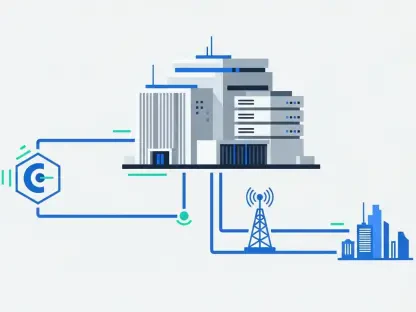At first glance, the financial performance of Cellnex Telecom, a dominant player in Europe’s telecommunications infrastructure sector, seems to signal a promising recovery with its latest quarterly earnings report reflecting a substantial profit surge. Known for leasing cell towers to mobile operators across the continent, the company reported a significant statutory profit increase, largely driven by a one-time tax benefit of €540 million. This boost paints a picture of strength and stability, capturing the attention of investors eager for positive developments. Yet, beneath this apparent success lies a complex web of potential vulnerabilities that could undermine long-term profitability and stock performance. From unsustainable financial gains to operational fragilities and external pressures, a deeper examination reveals concerns that may not be immediately visible in headline figures. This article explores whether the reported earnings truly reflect robust health or mask deeper risks that could impact the company’s future.
Beneath the Surface of Profit Gains
Scrutinizing the latest earnings report from Cellnex Telecom uncovers a critical detail: the reported profit surge is heavily reliant on a non-recurring tax benefit amounting to €540 million, derived from past tax losses. This one-time gain creates an illusion of a strong financial turnaround, bolstering statutory profits in a way that might mislead stakeholders about the company’s underlying performance. However, this windfall does not represent sustainable earnings power, as it stems from a unique circumstance unlikely to recur in subsequent quarters. With potential regulatory shifts on the horizon that could alter tax frameworks, the likelihood of similar boosts diminishes further. Investors must therefore look beyond these headline numbers to assess whether the core business operations can independently drive consistent growth, raising valid doubts about the reliability of the reported financial health in reflecting long-term stability.
Delving deeper into this issue, the absence of recurring profitability sources becomes a pressing concern for Cellnex Telecom’s future outlook. Without the tax benefit inflating the numbers, the earnings profile appears far less impressive, exposing a gap between perceived and actual financial strength. This discrepancy suggests that the company may struggle to maintain investor confidence if future reports lack similar extraordinary gains. The situational nature of such benefits also means that strategic planning cannot depend on them, forcing a focus on operational efficiency and revenue generation from core activities. Moreover, the market’s reaction to these inflated figures could lead to volatility in stock performance if expectations are not recalibrated to account for the temporary nature of the profit spike. This scenario underscores the importance of transparency in financial reporting to ensure that stakeholders have a clear understanding of what drives results.
Operational Struggles Amid Growth Metrics
Despite achieving a commendable 6% organic revenue growth and an 8.1% rise in EBITDA during the first half of the current year, Cellnex Telecom faces significant hurdles in converting these metrics into reliable profitability. The company missed earnings per share expectations by a staggering 772% and fell short on revenue projections by 3.1%, highlighting inefficiencies in managing costs and capital expenditures. These shortfalls indicate underlying operational challenges that could hinder the ability to sustain growth over time. As expenses continue to climb, possibly due to infrastructure maintenance or expansion efforts, the pressure on profit margins intensifies. This situation calls into question whether the reported growth figures are a true indicator of financial health or merely a facade hiding deeper systemic issues that need addressing.
Another layer of complexity arises from Cellnex Telecom’s dependence on long-term contracts with mobile network operators, which, while providing a steady revenue stream, also introduce risks of margin compression. If operators resist inflation-linked rate increases or seek to renegotiate terms amid economic pressures, the company’s already delicate operating margins could face further erosion. Additionally, the 10.2% growth in recurring levered free cash flow, though positive, must be weighed against these contractual uncertainties. Such dynamics suggest that maintaining profitability will require adept negotiation and cost management strategies to mitigate potential pushback from partners. The interplay between revenue growth and margin stability remains a critical area of focus, as failure to balance these elements could lead to diminished financial outcomes in future periods, impacting overall investor sentiment.
Financial Structure and Debt Pressures
The financial architecture of Cellnex Telecom reveals a troubling reliance on debt, which poses a substantial risk to its stability in an unpredictable economic environment. Recent strategic decisions, including a €750 million bond issuance and the refinancing of a €2.8 billion credit facility, have enhanced liquidity but also increased exposure to fixed-rate debt obligations. With prevailing high interest rates, the company’s net financial costs, reflected in a €416 million loss for the first half of the year, continue to drag on overall profitability. This heavy debt burden limits financial flexibility, making it challenging to allocate resources toward growth initiatives or weather economic downturns. The persistent strain of these obligations highlights a structural vulnerability that could exacerbate any adverse market conditions.
Beyond the immediate impact of debt, the broader implications for Cellnex Telecom’s financial health are significant, especially in a climate where interest rates may remain elevated or increase further. The company’s ability to service its debt without compromising operational investments is crucial, yet the current capital structure suggests a precarious balance. Elevated financial costs not only reduce net income but also limit the capacity to reinvest in critical areas like technology upgrades or market expansion. This scenario creates a vicious cycle where debt servicing constrains growth, potentially leading to stagnating revenues and further financial pressure. Addressing this challenge will require careful debt management strategies and possibly exploring equity financing options to reduce leverage, ensuring that the balance sheet does not become a long-term impediment to progress.
Balancing ESG Goals and External Risks
Cellnex Telecom’s dedication to environmental, social, and governance (ESG) initiatives, such as achieving ISO 50001 certification and investing in smart IoT solutions, positions it as a progressive entity in the telecommunications infrastructure space. These efforts, while commendable for enhancing corporate reputation and aligning with global sustainability trends, come with substantial financial commitments. If these investments do not yield measurable returns, they risk straining cash flows and compounding existing financial pressures. The challenge lies in balancing the pursuit of long-term societal benefits with the immediate need for fiscal prudence, as any misstep could divert resources from core operations. This delicate equilibrium will be pivotal in determining whether ESG commitments bolster or burden the company’s financial trajectory.
Adding to internal considerations, external uncertainties further complicate Cellnex Telecom’s outlook, particularly within Europe’s volatile telecom sector. Operating in key markets like France, with 26,000 points of presence, the company is exposed to macroeconomic instability and potential regulatory changes that could disrupt revenue projections. A recession or market consolidation might prompt mobile operators to renegotiate service agreements, threatening the stability of income streams. The current guidance for revenue and EBITDA assumes favorable conditions, but any deviation from this stability could derail expectations. Navigating these external risks will demand agility and proactive engagement with regulatory bodies and partners to safeguard against sudden shifts that could undermine financial performance, making adaptability a cornerstone of future strategy.
Navigating Future Uncertainties
Reflecting on the detailed analysis, it becomes evident that Cellnex Telecom’s recent financial uptick, driven by a temporary tax benefit, masks underlying issues that persist across operational and structural dimensions. The missed earnings targets and substantial debt costs highlight a fragility that cannot be ignored, while ESG investments and external economic risks add layers of complexity to the company’s path forward. Moving ahead, stakeholders should prioritize a focus on sustainable growth metrics over short-term gains, advocating for rigorous debt management to alleviate financial strain. Exploring innovative cost-control measures and fostering resilient partnerships with operators could fortify margins against inflationary pressures. Additionally, maintaining a keen eye on regulatory landscapes and economic indicators is essential to anticipate disruptions. These steps, taken with caution and foresight, will be critical in steering Cellnex through the turbulent waters of the telecom infrastructure sector.









